EGFIE LLC
We always add value to our customers
Search by Keyword
Product Categories
Based on our unique and proprietary “VIPs” and polymer synthesis technologies, currently we are developing and manufacturing three categories of DNA/siRNA transfection reagents, which show distinct transfection characteristics compared with the leading products in the market. What's more important is that the transfection reagents we are manufacturing are very affordable and will save your precious research budget.
Transfection Reagent Selection Chart.
| Reagents | Features | Transfection Type | Toxicity |
| DNAfect | - Traditional recipe with new formulation - Most affordable and efficient - Best for large scale virus, antibody and protein production |
DNA siRNA DNA/siRNA |
++++ |
| OKDNAfect | - Low toxicity for very sensitive cells - Maximum cell viability |
DNA siRNA DNA/siRNA |
++ |
| SupDNAfect | - 100% DNA condensing groups released - Efficient for commonly used cell types |
DNA siRNA DNA/siRNA |
+++ |
| SupDNAfect Plus |
- Enhanced conjugate for maximal efficiency - Extremely good for very long DNAs |
DNA siRNA DNA/siRNA |
++ |
| LenDNAfect | - Enhanced conjugate with liposome for maximal efficiency - Best for lentivirus, antibody and protein production |
DNA siRNA DNA/siRNA |
+++ |
| AllDNAfect | - Fluorinated cationic lipids - Best transfection efficiency with least toxicity |
DNA siRNA DNA/siRNA |
+ |
| ExcelDNAfect | - Biodegradable polycationic polymer - Excellent efficiency for common used mammalian cells |
DNA siRNA DNA/siRNA |
+++ |
Description
Based on our proprietary polymer synthesis technology, ExcelDNAfect Transfection Reagent is formulated as a biodegradable polymer based DNA transfection reagent that ensures effective and reproducible transfection on HEK293, COS-7, NIH-3T3, HeLa, CHO and a broad ranges of hard-to-transfect mammalian cells. ExcelDNAfect reagent is able to immobilize DNA migration during electrophoresis at very low concentration and form transfection complex within 5 minutes at RT. A remarkable feature of the reagent is the rapid and complete degradation of polymer after transfection complex endocytosis (Figure 1), leading to much less cytotoxicity. PolyJet™ reagent, 1.0 ml, is sufficient for ~667 transfections in 24 well plates or ~333 transfections in 6 well plates, providing a very affordable alternative to the leading products for transfecting a variety of commonly used and hard-to-transfect mammalian cells.
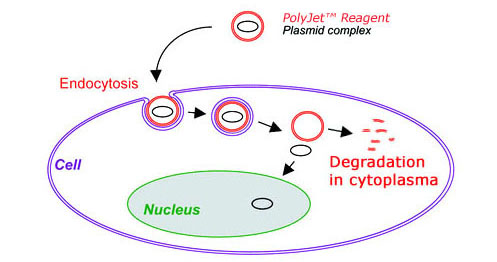
Figure 1. A Cartoon Showing Biodegradation of ExcelDNAfect Transfection Reagent After Endocytosis of Transfection Complex
Features
- Bio-degradable after endocytosis
- Exceptional high titers of virus production
- Equally good for very long DNAs (>89 kb)
- Equally good for both single DNA transfection and multi DNA co-transfection
- High levels of recombinant protein production
- Simple & robust transfection procedure
- Very affordable
Storage Condition
Store at 4 °C. If stored properly, the product is stable for 12 months or longer.
Broad Transfection Spectrum for Mammalian Cell Types
Examples Showing Transfection Efficiency of ExcelDNAfect Transfection Reagent on Commonly Used Cells
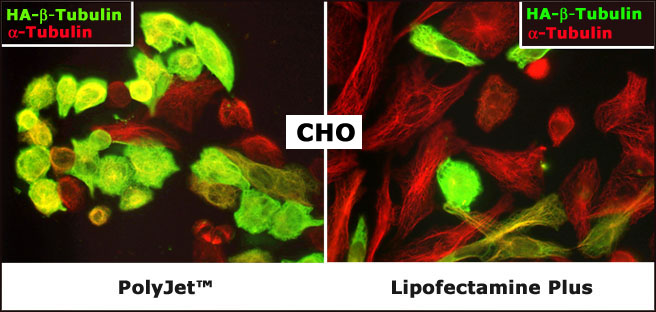
Transfection efficiency comparison of ExcelDNAfect vs. lipofectamine Plus on Chinese Hamster Ovary (CHO) cells. HA tagged beta-tubulin cDNA was delivered into CHO cells with PolyJet™ (left panel) and lipofectamine Plus (right panel) respectively. FITC conjugated antibody against HA tag was utilized to pick up HA-beta-tubulin (Green) while a DM1a antibody was used to detect endogenous alpha-tubulin followed by probing with rhodamine conjugated secondary antibody (Red). The above picture was provided by Dr. Shang Yin of University of Texas at Houston Medical School as courtesy
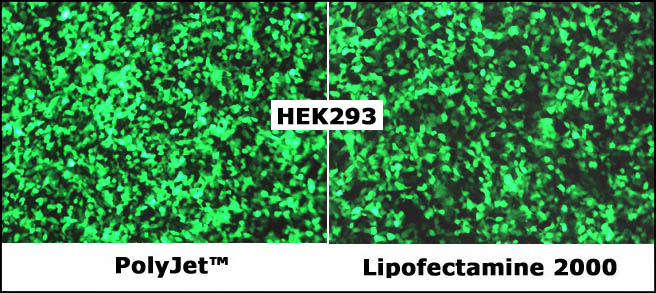
A comparison showing transfection efficiency of ExcelDNAfect reagent vs. a leading product, Lipofectamine 2000 on HEK293FT cells.HEK-293FT cells were transfected with GFP vector (pEGFP-N3) by ExcelDNAfect (left panel) and Lipofectamine 2000 (right panel) respectively. The cells were visualized by Nikon Eclipse Fluorescence microscope 24 hours post transfection
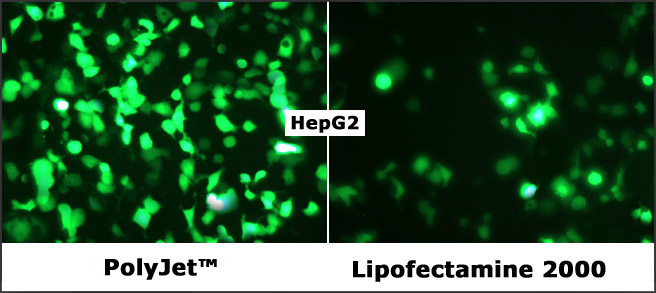
A comparison showing transfection efficiency of ExcelDNAfect reagent vs. a leading product, Lipofectamine 2000 on HepG2 cells.HepG2 cells were transfected with GFP vector (pEGFP-N3) by ExcelDNAfect (left panel) and Lipofectamine 2000 (right panel) respectively. The cells were visualized by Nikon Eclipse Fluorescence microscope 24 hours post transfection
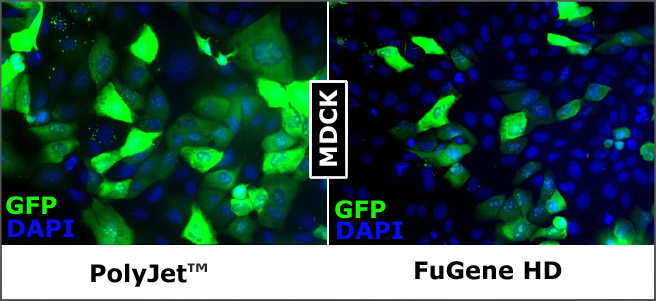
Transfection efficiency comparison of ExcelDNAfect vs. Fugene HD on MDCK cells. A plain GFP DNA was transduced into MDCK cells with PolyJet™ (left panel) and Fugene HD (right panel) reagents respectively per manufacturers' protocols. GFP and DAPI staining were visualized under fluorescence microscopy 48 hours post tansfection. The above comparison data and pictures were completed and provided by Dr. Ge Zhou of NYU Medical Center as courtesy
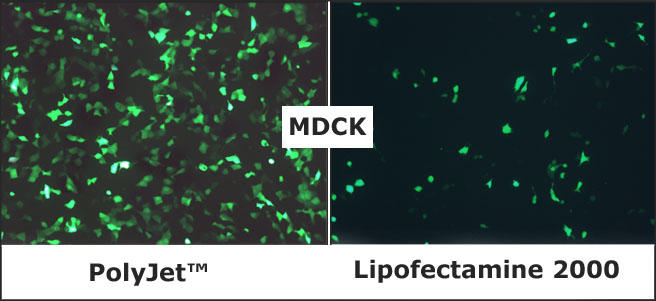
A comparison showing transfection efficiency of ExcelDNAfect reagent vs. a leading product, Lipofectamine 2000 on MDCK cells. MDCK cells are notoriously hard to transfect. With proprietary "Shaved Cell Transfection" protocol, ExcelDNAfect (left panel) gives up to 70% GFP positive cells vs. Lipofectamine 2000 (right panel) around 5% efficiency. MDCK cells were transfected with GFP vector (pEGFP-N3) by PolyJet™ (left panel) and Lipofectamine 2000 (right panel) respectively. The cells were visualized by Nikon Eclipse Fluorescence microscope 36 hours post transfection
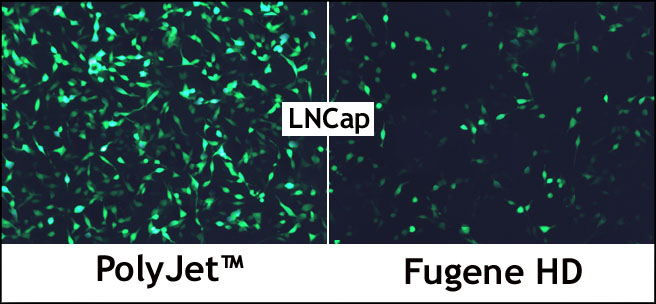
A comparison showing transfection efficiency of ExcelDNAfect reagent vs. a leading product, Fugene HD on LNCap cells. LNCap cells were transfected with GFP vector (pEGFP-N3) by PolyJet™ (left panel) and Fugene HD (right panel) respectively. The cells were visualized by Nikon Eclipse Fluorescence microscope 24 hours post transfection
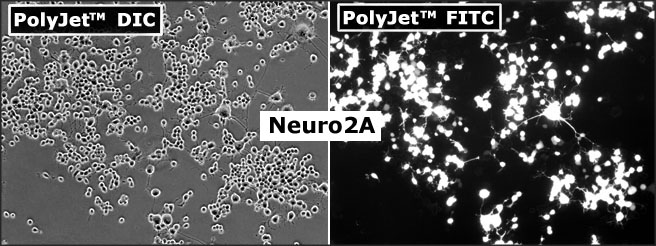
Neuro2A cells transfected with pEGFP-C1 plasmid using ExcelDNAfect Transfection Reagent. The Neuro2A cells were visualized by Nikon Eclipse Fluorescence microscope with DIC phase imaging (left) and FITC imaging (right) 24 hours post-transfection
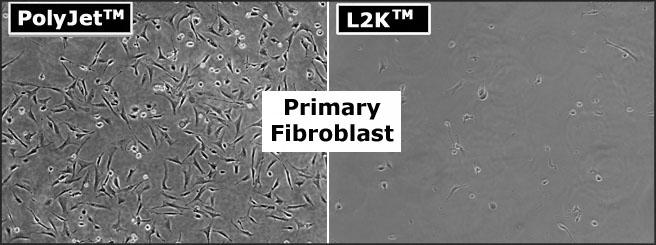
Comparison of cytotoxicity of ExcelDNAfect DNA In Vitro Transfection Reagent with L2K™ on primary murine skin fibroblast. The primary murine fibroblast was incubated with the indicated transfection reagents/pEGFP-C1 (DNA) complexes above for 4 hours in serum-free DMEM High Glucose medium followed by replacement of complete serum-containing medium. The cells were visualized by Nikon Eclipse Fluorescence microscope with DIC phase imaging 24 hours post transfection
Data Sheet and Protocols
- General Protocol for Transfecting Mammalian Cells
- A Short Protocol for Transfecting Mammalian Cells
- Advanced Protocol for Transfecting Hard-to-Transfect Mammalian Cells
- Protocol for Lentivirus Production
- Protocol for rAAV Production
Testimonials:
PolyJet Transfection Reagent worked equally as well as lipofectamine 2000, with little evidence of cell death on 293, PC-3 and 22RV1 cells. I will defiantly consider switching over.
-----Tiffany Wallace, Ph.D., NCI / NIH
I only did side by side with the testing sample (PolyJet) and Lipo2000 with GFP transfection on COS-7 cells. The result was very good. PolyJet was even better than L2K.
------Feng Qiao, Ph.D., NEI / NIH
I tested the sample of PolyJet on my NIH-3T3 mouse fibroblasts this weekend. The results were much better than Lipofecatmine LTX. I'm attaching a powerpoint slide with my results (I did not quantify the % transfection efficiency, but the pictures get the point across). I found that the protocol for difficult-to-transfect cell lines worked better than the standard protocol.
-----Stephanie Murphy, Ph.D., Dartmouth College
I had chance to try your product finally. It was great success. I used HeLa cells and got 10% transfection efficiency (<0.1% for Lipofectamine). Thank you! I was wondering if I also try GenJet™ Plus DNA In Vitro Transfection Reagent? According to your website, the reagent works better than regular PolyJet.
-------Yumi Uetake, Ph.D., UMASS
I tested PolyJet and it looks great on MDCK. We placed order. Thank you!
-------Ge Zhou, Ph.D., NYU
We are happy to provide feedback. PolyJet worked very well for us in HepG2 cells, we got approximately 80% efficiency with pMAX GFP plasmid, by following the conditions in your suggested protocol. We ran a comparison with Lipofectamine, which only showed approximately 20-30% transfection efficiency. We are planning experiments and will be ordering more soon.
-------Emily Mcallister, PBRC

Figure 1. A Cartoon Showing Biodegradation of ExcelDNAfect Transfection Reagent After Endocytosis of Transfection Complex
Features
- Bio-degradable after endocytosis
- Exceptional high titers of virus production
- Equally good for very long DNAs (>89 kb)
- Equally good for both single DNA transfection and multi DNA co-transfection
- High levels of recombinant protein production
- Simple & robust transfection procedure
- Very affordable
Storage Condition
Store at 4 °C. If stored properly, the product is stable for 12 months or longer.
Broad Transfection Spectrum for Mammalian Cell Types
| Cell Lines | Efficiency (% GFP) | Cell Lines | Efficiency (% GFP) |
| McArdle 7777 Hep3D SHEP 3T3-442A COS-7 CV-1 D 407 DHD Pro.b 3LL B16-F10 BAEC BHK-21 Ca Ski CaCo2 CHO HCS-2/8 HEK-293 HeLa HLMEC H-MVEC Huh-7D12 ATT20 SK-N-SH C2C12 HepG2 |
65-70% 67-76% 68-71% 35% 85-90% 60% 70% 70% 80% 85% 51% 80% 88% 60% 88% 61% 86% 88% 72% 59% 72% 46% 29% 46% 72% |
SAOS-2 SN56 MC3T3-E1 Primary melanocyte K562 L929 MCF-7 MDCK Neuro2A NIH 3T3 PC12 SH-SY5Y SiHa SKOV3 Huh-7 IGROV1 DF-1, Chicken Embryonic Cell 6CSFMEo WEHI 231 A549 LNCap Prim. mouse keratinocyte Prim. human skin fibroblast Prim. human pre-adipocyte Prim. mouse embry. fibroblast |
58% 81% 80% 35% 38% 59% 68% 68% 86% 76% 50% 25% 60% 65% 70% 35% 50% 71% 26% 75% 75 29% 50% 32% 30% |
Examples Showing Transfection Efficiency of ExcelDNAfect Transfection Reagent on Commonly Used Cells

Transfection efficiency comparison of ExcelDNAfect vs. lipofectamine Plus on Chinese Hamster Ovary (CHO) cells. HA tagged beta-tubulin cDNA was delivered into CHO cells with PolyJet™ (left panel) and lipofectamine Plus (right panel) respectively. FITC conjugated antibody against HA tag was utilized to pick up HA-beta-tubulin (Green) while a DM1a antibody was used to detect endogenous alpha-tubulin followed by probing with rhodamine conjugated secondary antibody (Red). The above picture was provided by Dr. Shang Yin of University of Texas at Houston Medical School as courtesy

A comparison showing transfection efficiency of ExcelDNAfect reagent vs. a leading product, Lipofectamine 2000 on HEK293FT cells.HEK-293FT cells were transfected with GFP vector (pEGFP-N3) by ExcelDNAfect (left panel) and Lipofectamine 2000 (right panel) respectively. The cells were visualized by Nikon Eclipse Fluorescence microscope 24 hours post transfection

A comparison showing transfection efficiency of ExcelDNAfect reagent vs. a leading product, Lipofectamine 2000 on HepG2 cells.HepG2 cells were transfected with GFP vector (pEGFP-N3) by ExcelDNAfect (left panel) and Lipofectamine 2000 (right panel) respectively. The cells were visualized by Nikon Eclipse Fluorescence microscope 24 hours post transfection

Transfection efficiency comparison of ExcelDNAfect vs. Fugene HD on MDCK cells. A plain GFP DNA was transduced into MDCK cells with PolyJet™ (left panel) and Fugene HD (right panel) reagents respectively per manufacturers' protocols. GFP and DAPI staining were visualized under fluorescence microscopy 48 hours post tansfection. The above comparison data and pictures were completed and provided by Dr. Ge Zhou of NYU Medical Center as courtesy

A comparison showing transfection efficiency of ExcelDNAfect reagent vs. a leading product, Lipofectamine 2000 on MDCK cells. MDCK cells are notoriously hard to transfect. With proprietary "Shaved Cell Transfection" protocol, ExcelDNAfect (left panel) gives up to 70% GFP positive cells vs. Lipofectamine 2000 (right panel) around 5% efficiency. MDCK cells were transfected with GFP vector (pEGFP-N3) by PolyJet™ (left panel) and Lipofectamine 2000 (right panel) respectively. The cells were visualized by Nikon Eclipse Fluorescence microscope 36 hours post transfection

A comparison showing transfection efficiency of ExcelDNAfect reagent vs. a leading product, Fugene HD on LNCap cells. LNCap cells were transfected with GFP vector (pEGFP-N3) by PolyJet™ (left panel) and Fugene HD (right panel) respectively. The cells were visualized by Nikon Eclipse Fluorescence microscope 24 hours post transfection

Neuro2A cells transfected with pEGFP-C1 plasmid using ExcelDNAfect Transfection Reagent. The Neuro2A cells were visualized by Nikon Eclipse Fluorescence microscope with DIC phase imaging (left) and FITC imaging (right) 24 hours post-transfection

Comparison of cytotoxicity of ExcelDNAfect DNA In Vitro Transfection Reagent with L2K™ on primary murine skin fibroblast. The primary murine fibroblast was incubated with the indicated transfection reagents/pEGFP-C1 (DNA) complexes above for 4 hours in serum-free DMEM High Glucose medium followed by replacement of complete serum-containing medium. The cells were visualized by Nikon Eclipse Fluorescence microscope with DIC phase imaging 24 hours post transfection
Data Sheet and Protocols
- General Protocol for Transfecting Mammalian Cells
- A Short Protocol for Transfecting Mammalian Cells
- Advanced Protocol for Transfecting Hard-to-Transfect Mammalian Cells
- Protocol for Lentivirus Production
- Protocol for rAAV Production
Testimonials:
PolyJet Transfection Reagent worked equally as well as lipofectamine 2000, with little evidence of cell death on 293, PC-3 and 22RV1 cells. I will defiantly consider switching over.
-----Tiffany Wallace, Ph.D., NCI / NIH
I only did side by side with the testing sample (PolyJet) and Lipo2000 with GFP transfection on COS-7 cells. The result was very good. PolyJet was even better than L2K.
------Feng Qiao, Ph.D., NEI / NIH
I tested the sample of PolyJet on my NIH-3T3 mouse fibroblasts this weekend. The results were much better than Lipofecatmine LTX. I'm attaching a powerpoint slide with my results (I did not quantify the % transfection efficiency, but the pictures get the point across). I found that the protocol for difficult-to-transfect cell lines worked better than the standard protocol.
-----Stephanie Murphy, Ph.D., Dartmouth College
I had chance to try your product finally. It was great success. I used HeLa cells and got 10% transfection efficiency (<0.1% for Lipofectamine). Thank you! I was wondering if I also try GenJet™ Plus DNA In Vitro Transfection Reagent? According to your website, the reagent works better than regular PolyJet.
-------Yumi Uetake, Ph.D., UMASS
I tested PolyJet and it looks great on MDCK. We placed order. Thank you!
-------Ge Zhou, Ph.D., NYU
We are happy to provide feedback. PolyJet worked very well for us in HepG2 cells, we got approximately 80% efficiency with pMAX GFP plasmid, by following the conditions in your suggested protocol. We ran a comparison with Lipofectamine, which only showed approximately 20-30% transfection efficiency. We are planning experiments and will be ordering more soon.
-------Emily Mcallister, PBRC
Shopping Basket
| Items: | 0 |
| Subtotal: | $0.00 |
Note: All prices in US Dollars
customer@egfie.com